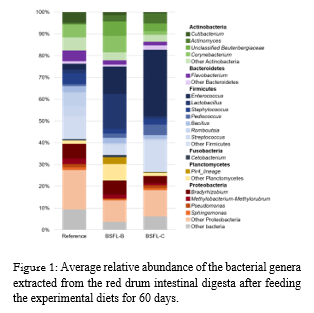NUTRITIONAL VALUE OF BLACK SOLDIER FLY Hermetia illucens REARED IN TWO DIFFERENT SUBSTRATES, AND THEIR EFFECT ON GROWTH PERFORMANCE, IMMUNE RESPONSES, AND INTESTINAL MICROBIOTA WHEN PARTIALLY REPLACING FISHMEAL IN DIETS FOR JUVENILE RED DRUM Sciaenops ocellatus
Black soldier fly larvae meal has been identified as a promising ingredient for aquafeeds due to its nutritional composition and high production capacity on relatively low-value substrates . In the current study, two b lack soldier fly meals were produced when the larvae were reared in Brewer's spent grains (BSFL-B ) and a commercially available substrate (BSFL-C). Nutrient composition of the BSFL meals were significantly impacted by their feeding substrates where the larvae fed spent grains presented higher lipid and energy contents , and lower ash content than those reared o n the commercial substrate.
For the comparative feeding trial, a reference diet was formulated for red drum with practical ingredients to be similar to a commercial diet with menhaden fishmeal included at 15.45% of dry weight. T he experimental diets contained the two larvae meals replacing 65 % of the menhaden fishmeal in the reference diet on an equal weight basis . Groups of 12 fish (~5.6 g) were stocked in 15, 38-L aquaria, and the three experimental diets were distributed in a completely randomized block design (n=5). After 8 weeks, fish fed BSFL-B diets presented impaired weight gain and feed efficiency (FE) when compared to those fed the reference diet . Red drum fed BSFL-C diets had growth performance numerically lower, but not statistically different, than the fish fed the reference diet. H igher mineral and lower lipid content were observed in whole-body tissues of fish fed the reference diet when compared to fish fed either BSFL meals. The remaining red drum had their intestinal d igesta aseptically collected, and b acterial DNA was extracted to assess possible differences in microbial communities using next-generation sequencing (NGS) (Figure 1). The dietary treatments significantly impacted the intestinal microbiome in relative abundances of bacteria and the predicted functions of the bacterial metagenome using PICRUSt2. Alpha- and beta-diversity metrics of the bacterial communities also were significantly affected by the experimental diets . In conclusion, a partial replacement of fishmeal could be achieved with BSFL- C without significantly impairing growth performance, and both BSFL meals altered the intestinal microbiome when compared to red drum fed a reference diet.
